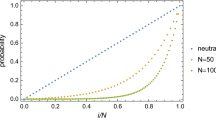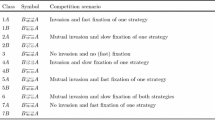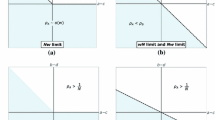Abstract
We show that the extension of the one-third law of evolution from the 2-player game to the d-player game is the same for all exchangeable models in the domain of application of the Kingman coalescent in the limit of a large neutral population. The extension relies on an approximation of the probability of fixation of a single mutant in terms of expected times in ancestral sample states that are calculated by induction. An interpretation based on the concept of projected average excess in payoff is discussed.
Similar content being viewed by others
References
Cannings C (1974) The latent roots of certain Markov chains arising in genetics: a new approach. I. Haploid models. Adv Appl Probab 6:260–290
Eldon B, Wakeley J (2006) Coalescent processes when the distribution of offspring number among individuals is highly skewed. Genetics 172:2621–2633
Fisher RA (1930) The genetical theory of natural selection. Clarendon, Oxford
Gokhale CS, Traulsen A (2010) Evolutionary games in the multiverse. Proc Natl Acad Sci USA 107:5500–5504
Imhof LA, Nowak MA (2006) Evolutionary game dynamics in a Wright–Fisher process. J Math Biol 52:667–681
Kingman JFC (1982) The coalescent. Stoch Process Appl 13:235–248
Kurokawa S, Ihara Y (2009) Emergence of cooperation in public goods games. Proc R Soc B 276:1379–1384
Lessard S (2005) Long-term stability from fixation probabilities in finite populations: new perspectives for ESS theory. Theor Popul Biol 68:19–27
Lessard S (2007) Cooperation is less likely to evolve in a finite population with a highly skewed distribution of family size. Proc R Soc B 274:1861–1865
Lessard S, Ladret V (2007) The probability of fixation of a single mutant in an exchangeable selection model. J Math Biol 54:721–744
Lessard S, Lahaie P (2009) Fixation probability with multiple alleles and projected average allelic effect on selection. Theor Popul Biol 75:266–277
Möhle M (2000) Total variation distances and rates of convergence for ancestral coalescent processes in exchangeable population models. Adv Appl Probab 32:983–993
Moran PAP (1958) Random processes in genetics. Proc Camb Philos Soc 54:60–71
Nowak MA, Sasaki A, Taylor C, Fudenberg D (2004) Emergence of cooperation and evolutionary stability in finite populations. Nature 428:646–650
Pitman J (1999) Coalescents with multiple collisions. Ann Probab 27:1870–1902
Rousset F (2003) A minimal derivation of convergence stability measures. J Theor Biol 221:665–668
Sagitov S (1999) The general coalescent with asynchronous mergers of ancestral lines. J Appl Probab 36:1116–1125
Wright S (1931) Evolution in Mendelian populations. Genetics 16:97–159
Author information
Authors and Affiliations
Corresponding author
Additional information
Research supported in part by the Natural Sciences and Engineering Research Council of Canada.
Rights and permissions
About this article
Cite this article
Lessard, S. On the Robustness of the Extension of the One-Third Law of Evolution to the Multi-Player Game. Dyn Games Appl 1, 408–418 (2011). https://doi.org/10.1007/s13235-011-0010-y
Published:
Issue Date:
DOI: https://doi.org/10.1007/s13235-011-0010-y




